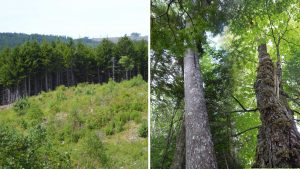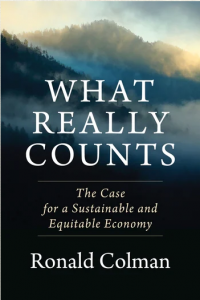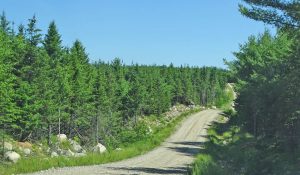
Two woodlots in Nova Scotia, one involving clearcut forestry and promoting softwoods, the other involving selection management and maintaining a mixed, multi-aged Acadian forest.
It seems that over a full rotation, the costs of HPF approach or exceed the profits; Greg Watson asks “who’s going to pay for it, and if it’s the taxpayer, are they willing to foot the bill? “
An article by Aaron Beswick in the Chronicle Herald Saturday Print Ed. – The future of Crown land: where politics, forestry, environment meet (view image on WWNS), also published online under saltwire.com – features some illuminating comments by Greg Watson, Manager of the North Nova Forest Owners Co-op. They concern the economic viability of HPF (High production Forestry) and Ecological Forestry which would be implemented in the HPF and Ecological Matrix components of Lahey et al’s Triad once that is finally implemented.
Says Watson, “The HPF model is comparable to agriculture, as the land is intensively managed to increase the quantity and quality of a defined set of products over a specified time”. He cites figures from his own experience with a similarly managed stand (put in a table format below by NSFN):
| Treatment | Gain (+) or Cost (-) | Balance |
| Clearcut 2003 | + $2500/acre | +$2500 |
| Replanted 2005 with spruce | -$600/acre | +$1900 |
| Herbicide 2007 | -$250/acre | +$1650 |
| Pre-commercial thinning in 2017 | -$800/acre | +$850 |
| 2nd herbicide treatment required | -250/acre | +$600 |
| Poss. 2nd pre-commercial thinning | -$800/acre | -$200 |
Watson comments that these figures do not include soil amendments which could bring the costs well over what is gained from harvesting.
So Watson’s question is “who’s going to pay for it, and if it’s the taxpayer, are they willing to foot the bill? “[And, one might ask, if it’s the taxpayer footing the bill, what are the implications for selling softwood lumber to the USA; could we lose our usual tariff exemption?]
Watson describes an adjacent stand- “mature hemlock dominated – [that] was treated essentially the same as the province’s plan for the ecologically managed leg of the triad and the numbers suggest is more profitable and protects the principle”.
“When I put on my forestry hat and look at this like a bank account, there is still principal here,” said Watson. “I’m not against high production forestry but what we don’t have is the research to say over a hundred years what provides a greater return, but my gut feeling is this is better.”
Beyond protecting the soil and providing habitat it [the ecologically managed stand] is also more palatable to an increasingly environmentally conscious public that will pressure politicians over time when they see high production forestry going on next door.
The return on the required investments to make the high production forestry leg successful, worries Watson, rely not just on the views of the polticians running in this election but in all those to come over the ensuing 50 years.
As I understand it, by “the principal” Watson means an intact forest system. Please read the article for details.
I assume that the $800 for thinnings cited above could be partially or wholly recovered if there is a market for “low value wood”.
Regardless of the uncertainties of these back-of-the-envelop calculations, at least what we have on the table with this example is some estimate of the real cost of industrial forestry in NS. Hopefully it will prompt publication of a more refined and fully public accounting for the costs of supporting industrial forestry in NS which has not been forthcoming from successive provincial governments.
It is an estimate of the real cost, because it is intended that these HPF forests are sustainable as HPF forests – they are not “clearcut and run”.*
*“sustainable as HPF forests”, i.e. wood production will be maintained. I hope they will be designed to contribute also to sustainability of forest biodiviversity, i.e..by retaining patches of older forest, corridors of older forest and wide riparian/no logging zones. Currently there are large swaths of these lands that are not characterized by such features.
 In 2021, we must surely also include in any accounting the costs accrued by loss of Ecosystems Services associated with intensive forestry (e.g. due to loss of carbon storage and diverse recreational opportunities, more extreme flooding) and/or – depending on how the accounting is done – to add to the income side, the benefits of Ecological Forestry for Ecosystem Services.
In 2021, we must surely also include in any accounting the costs accrued by loss of Ecosystems Services associated with intensive forestry (e.g. due to loss of carbon storage and diverse recreational opportunities, more extreme flooding) and/or – depending on how the accounting is done – to add to the income side, the benefits of Ecological Forestry for Ecosystem Services.
Ron Coleman & colleagues laid the groundwork for such accounting 20 years ago – in NS and specifically in relation to forests and forestry – with their Genuine Progress Index.*
*The Nova Scotia GPI Forest Accounts Volume 1: Indicators of Ecological, Economic & Social Values of Forests in Nova Scotia (2001) by Sara Wilson, Ronald Colman, Minga O’Brien Linda Pannozzo. View also the 2008 Update by Pannozzo and O’Brien.
 Ron Colman recently published WHAT REALLY COUNTS: The Case for a Sustainable and Equitable Economy, Columbia University Press 2021 (view Post, May 10, 2021). Colman recounts in the book how they handed over their Nova Scotia GPI database to the new NDP Government in 2009 as the NDP in their election platform had promised to adopt the GPI and use it to make policy. However, says Colman, once in power, “the silence was deafening” and “to this day our Nova Scotia GPI database sits at the provincial statistics agency untouched and unused, with no interest from two successor governments.”
Ron Colman recently published WHAT REALLY COUNTS: The Case for a Sustainable and Equitable Economy, Columbia University Press 2021 (view Post, May 10, 2021). Colman recounts in the book how they handed over their Nova Scotia GPI database to the new NDP Government in 2009 as the NDP in their election platform had promised to adopt the GPI and use it to make policy. However, says Colman, once in power, “the silence was deafening” and “to this day our Nova Scotia GPI database sits at the provincial statistics agency untouched and unused, with no interest from two successor governments.”
Surely coming out of the experiences of Covid and with the acknowledgment by all political parties that we must now address the dual and linked crises of climate warming and biodiversity loss, it is time for such comprehensive accounting to be applied, no matter where it leads. I’m hoping Greg Watson gave that a bit of kick start in relation to forestry.
Thx to Aaron Beswick & the Chronicle Herald for an insightful article; and Thx to Greg Watson for sharing your views and experience with the public as well as with government.
There’s lots more in the article, e.g, answers to four questions provided to the Liberal, PC and NDP parties regarding the implementation of the Lahey recommendations.
——–
Aug 4, 2021: View some discussion of this post on Annapolis Royal & Area – Environment & Ecology (Public Facebook Group)
——–
Some related posts on NSFN
Rankin calls Nova Scotia election, two forestry Guides released the day before but no Progress Report from Lahey 19Jul2021
Post on NSFN July 19, 2021
Nova Scotia election looming & concerns about wood supply from Crown lands, the Lahey Progress Report, promised consultations, carbon sequestration and “low value wood” 9July2021
Post on NSFN July 9, 2021
Achieving Net Zero for Nova Scotia: can we take a lead from Dr. Strang? 26Jun2021
Post on NSFN June 26, 2021 The pandemic & Dr. Strang have taught us a lot about how to use ‘the science’ to deal with complex issues, and to date, at least, we have done it better than most other jurisdictions; why not apply the same approach to achieve Net Zero for Nova Scotia?
Draft Nova Scotia Forestry EA Process surfaces 21May2021
Post on NSFN May 21, 2021 It appears Talk and Log will continue for another four years after the Lahey Recommendations are implemented
Is High Production Forestry compatible with the Nova Scotia Premier’s commitment to carbon neutrality? 11Mar2021
Post on NSFN Mar 11, 2021 Simply put, one cannot make the assumption that “implementing the Lahey recommendations” will help to mitigate climate change
For the record: Rankin’s first comments as premier of Nova Scotia on implementing the Lahey Report & Owl’s Head 25Feb 2021
Post on NSFN Feb 25, 2021
Comment on the revised SGEM for Nova Scotia: an inconvenient truth about our soils 16Feb2021
Post on NSFN Feb 16, 2021 Soils over more than 50% of the forested landscape in Nova Scotia simply need time to recover if we are ever to achieve truly sustainable harvesting, and to conserve and restore forest and aquatic biodiversity. At a minimum, we need to reduce the harvest on Crown lands to 500,000 cubic meters per year (from 820,576 cubic metres in 2019).
Forest Nova Scotia’s “simple math” underscores key issue for success or failure of Government’s implementation of Lahey Recommendations: How much wood is to be taken from Crown lands? 22Jan 2021
Post on NSFN Jan 22, 2021
A question to the Nova Scotia Liberal Leadership Candidates: How do you plan to align Nova Scotia with the federal Liberal Government’s commitment to 30% Protected Area by 2030? 2Jan 2021
Post on NSFN Jan 2, 2021 The question was also asked of leaders of the PC, NDP and Green parties. Only the NDP responded. View all responses
An assessment of Nova Scotia L&F’s progress in implementing Ecological Forestry in response to the Lahey Report, Part 3: The Project Muddle 8Sep2020
Post on NSFN Sep 8, 2020
Shelly Hipson: Concerns about how Crown lands will be designated for High Production Forestry in Nova Scotia 11May 2020
Post on NSFN May 11, 2020

